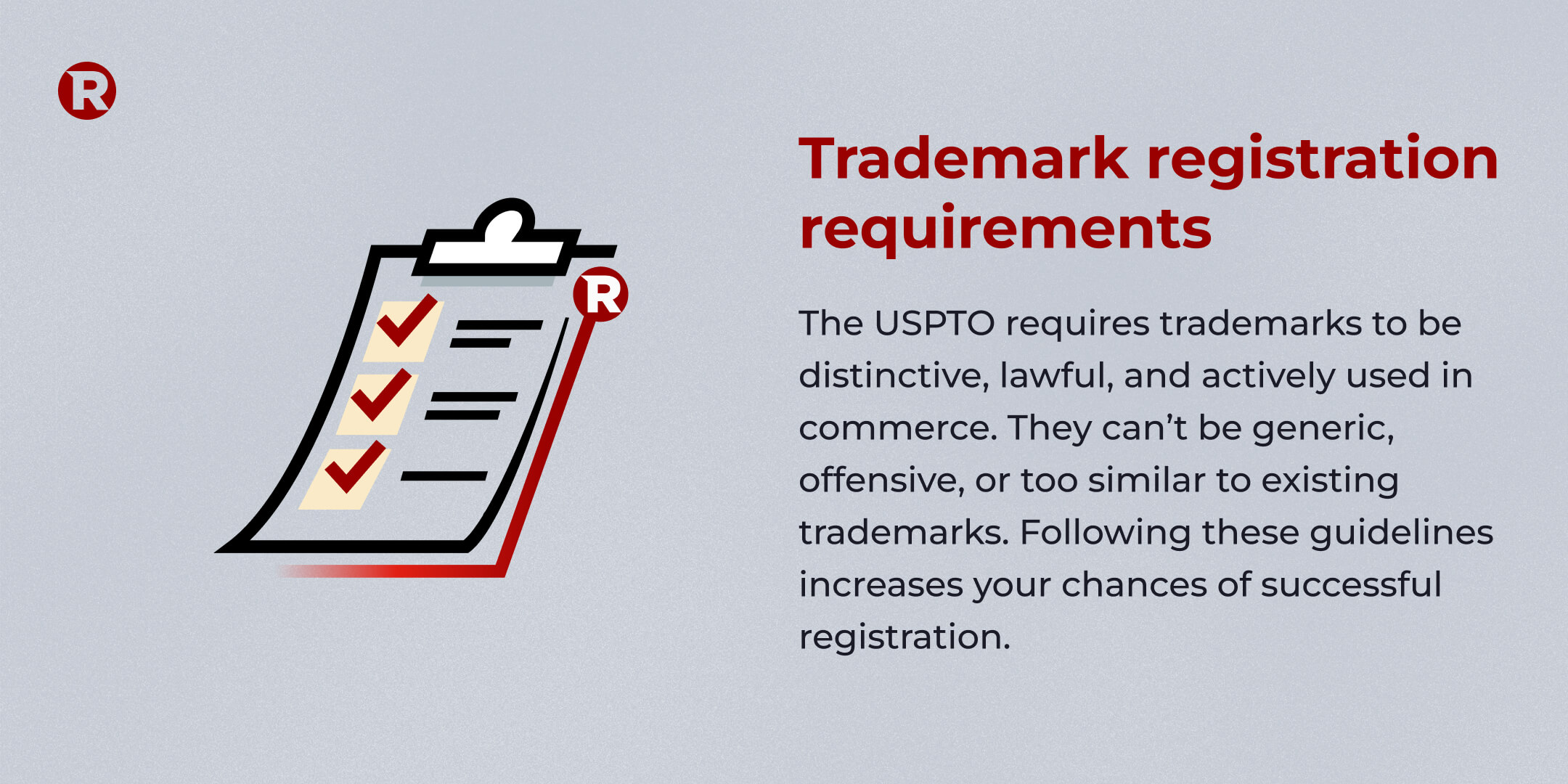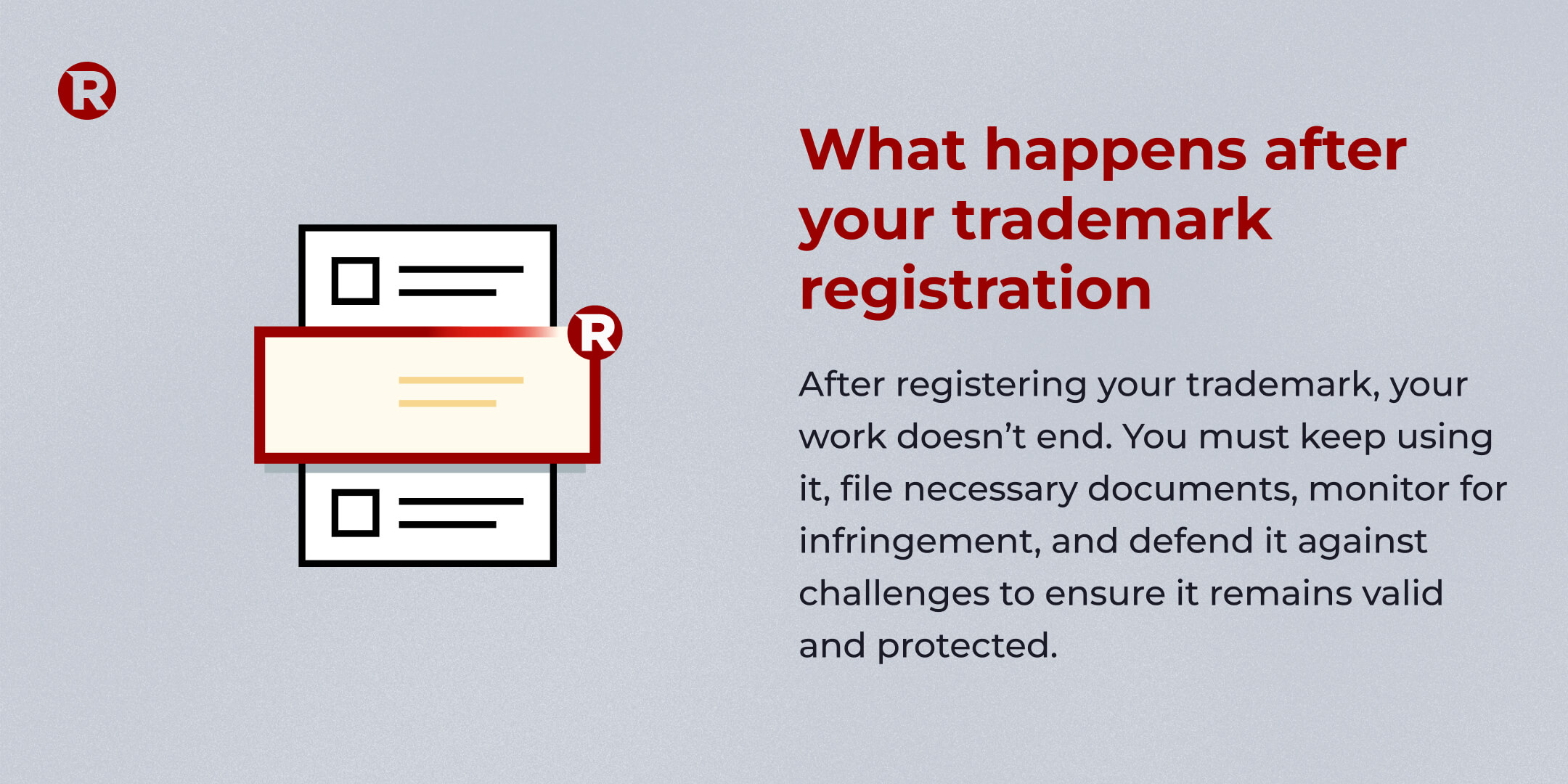The process to register a trademark often involves multiple steps including a trademark search, research, filling out the right form, and responding to USPTO questions and objections.


A trademark gives legal protection to the unique elements that set your business apart, such as brand names, logos, and slogans. Knowing how to register a trademark is very important for any business owner who wants to protect their brand – this guide will take you through each step of the registration process in detail, making it easier for you to protect your brand's identity.
1. Select your trademark
The first step in registering a trademark is to decide what your trademark will be. It could be a brand name, logo, slogan, or any unique intellectual property that represents your business. This is really important because your trademark is what people will think of when they hear about your brand.
When you're picking a trademark, there are a few key things to keep in mind:
a) Make it unique
Your trademark must be different enough to make your brand stand out from others. Trademarks are grouped based on how distinctive they are, from generic and descriptive to suggestive, arbitrary, and fanciful. Here’s what each of those means:
|
GENERIC |
A generic term is a common name for a product or service. For example, you can’t trademark the word "computer" as a business name for computer products because it’s a term everyone uses. |
|
DESCRIPTIVE |
These trademarks describe a feature of the product. For example, "Creamy Yogurt" for a yogurt brand would be descriptive. Descriptive marks can be protected only if they've been used for a long time and people recognize them as a brand (this is called "secondary meaning"). |
|
SUGGESTIVE |
Suggestive trademarks hint at a product's features but need some imagination to figure out – "Netflix" suggests internet movies without directly saying it. |
|
ARBITRARY |
Arbitrary trademarks use common words in a different context. "Apple" and “Amazon” are examples of arbitrary marks, because they use those words in different industries to what they refer to. |
|
FANCIFUL |
Fanciful trademarks are made-up words that don’t have any meaning, like "Kodak" or "Xerox." These are the strongest trademarks because they are completely unique. |
b) Make it relevant
Your trademark should match what your brand is all about. For instance, if you're selling high-end jewelry, a fun or casual name might not send the right message to your customers.
c) Make it flexible
Think about how your business might grow in the future. Picking a trademark that can fit future new products or services can help avoid the hassle of rebranding down the road.
2. Make sure your trademark meets registration requirements

The United States Patent and Trademark Office (USPTO) has strict guidelines on how to register a trademark to make sure that trademarks don't cause confusion or copy existing ones. Here are the main requirements:
- Distinctiveness: the USPTO won’t register something generic or too descriptive unless it has become distinctive over time. The more unique your trademark is, the easier it will be to register and protect.
- Non-conflicting: your trademark can’t be too similar to another trademark in the same industry. If it's likely to be confused with an existing trademark, the USPTO will reject your application. This is why it's important to do a good trademark search before applying.
- Lawful use: your trademark must not be offensive or misleading. For example, you can’t trademark a logo that suggests your product has benefits it doesn’t actually have. Also, trademarks that look like government symbols or official badges can’t be registered.
- Commercial use: in the U.S., you need to be using the trademark in the sale of goods and services to register it. If you haven’t started using it yet, you can file an "Intent to Use" application, which holds your spot for up to three years until you begin using it.
- No prohibited marks: Some marks are completely off-limits, like flags, government insignias, and certain names. Make sure your trademark doesn't fall into any of these categories.
During the review process, the USPTO might have questions or need more information about your application. Don’t worry – this is normal.
3. Perform a trademark search
One of the most important steps in the registration process is doing a detailed trademark search. This helps you make sure that your service mark isn’t already being used by another business in a similar field. A good search can save you time, money, and potential legal issues down the road.
- Use the USPTO’s database. The USPTO database lets you search for existing trademarks in their Trademark Electronic Search System (TESS), but it can be tricky to use if you’re not familiar with it.
- Consider variations and related trademarks. When searching, you might want to look for different versions of your trademark. For example, if your trademark is "Sunshine Shoes," you could also search for similar names like "Sun Shoes," "Sunshine Apparel," or "Sunny Shoes." Even small differences can cause problems.
- Check for common law trademarks. Not all trademarks are officially registered with the USPTO. Some businesses use trademarks under "common law" rights, meaning they own the trademark just by using it. Common law trademarks can still lead to legal trouble, so you should look for these too by searching online, looking at business directories, and even checking state trademark databases.
- Hire a Professional. Since trademark searches can be complicated, many businesses hire a trademark attorney or a search service to help. Rocket Lawyer can help with filing a trademark!
A proper trademark search is an investment in your brand’s future, helping you avoid expensive disputes and ensuring your trademark is unique.
4. Research your trademark’s class of goods
After you've confirmed that your trademark is available, the next step is to decide which trademark class of goods to register it under. Trademarks are divided into 45 different classes based on the type of goods and services they represent: 34 classes for goods and 11 for services.
Picking the right class is important because your trademark protection only applies to the goods or services in that class. If your business offers products or services in more than one category, you might need to register in multiple classes. For example, if you sell both clothing and cosmetics, you would need to register in Class 25 (clothing) and Class 3 (cosmetics).
If you’re unsure which classes to choose, asking a trademark lawyer that has experience with filing trademark application can be helpful to ensure you are selecting the right categories
5. Fill out the trademark application form
With your trademark chosen, searched, and classified, it’s time to fill out the trademark application form. The U.S. Patent and Trademark Office offers an online application system called the Trademark Electronic Application System (TEAS). Here’s how to fill it out:
- Pick the right form. The USPTO has two filing options: TEAS Plus and TEAS Standard. TEAS Plus is cheaper but has stricter requirements, like choosing goods and services from their ID manual. TEAS Standard costs more but gives you more freedom in describing your goods or services. Choose the filing option that works best for you.
- Enter your information. You'll need to fill out the form with your information (name, address, contact details, etc.). If you're applying for a business, include the business’s legal name and type (like Limited Liability Company or corporation).
- Describe your trademark. If your trademark is a name, just enter the name. If it’s a logo or design, upload a clear, high-quality image of it. Make sure the image shows the trademark exactly how it will be used. If it is any other type, describe any colors, shapes, or unique features.
- Identify the goods or services. Next, choose the goods or services your trademark will cover. Use your research on trademark classes to pick the right one(s) and give detailed descriptions of the goods or services in those classes.
- Specify the filing basis. If you’re already using the trademark, select "Use in Commerce." If you haven’t started using it yet, select "Intent to Use."
- Pay the filing fees. The fees depend on the number of classes you select and the form you use. Pay them to finish your application process.
6. Submit your trademark registration application
After you finish filling out the application form, all you have to do is submit it to the USPTO. Here’s what happens next:
- Once you submit your application, the USPTO will give you a filing receipt. The receipt confirms they got your submission and gives you a serial number that you can use to check on the status of your application.
- Your application will be reviewed by a trademark attorney at the USPTO to make sure it meets all the legal requirements. They’ll check if your trademark conflicts with any existing ones, if it’s unique enough, and if all the needed information is included.
- If the attorney approves your application, it will be published in the USPTO’s Official Gazette. This lets the public see your trademark and gives them a chance to object if they think it infringes on their existing trademark (usually because it’s a similar mark to theirs).
Submitting your application is a big step, but it’s just the beginning. The whole process to get your registered mark, from submission to trademark registration, can take anywhere from 8 to 18 months, depending on how complex your application is and if any issues come up during the review. Which takes us to our next step…
7. Respond to the USPTO in time
During the review process, the USPTO might have questions or need more information about your application. Don’t worry – this is normal.
When this happens, the USPTO will send you an Office Action, a document that explains the issues they found and how to fix them. Common problems include missing information or conflicts with other trademarks. You’ll have three months to respond to an Office Action. If you’re unsure about how to respond, consider working with a trademark attorney, as they can guide you through the process and help with any challenges.
After you respond to any Office Actions and make any needed changes, the examining USPTO attorney will make a final decision on your application. If it’s approved, your trademark moves to the next step. If it’s denied, you can either appeal the decision or make more changes.
8. Get your certificate
Once your trademark gets through the examination and is approved, the USPTO will give you a registration certificate. This certificate officially registers your trademark, giving you the exclusive right to use it for the goods and services you listed in your application.
What happens after your trademark registration

After you register your trademark, your work isn’t over. Keeping your trademark protected takes ongoing effort. Here’s what you need to do:
1. Maintaining your trademark
To keep your trademark alive, the USPTO requires that your trademark be used in connection with the goods and services you registered it for. If you stop using it for a long time (usually around three years), it might be considered abandoned, and you could lose your legal rights to it.
2. Filing maintenance documents
After registration, you’ll need to file certain documents with the USPTO at specific times. The first is a Section 8 Declaration of Continued Use, which confirms that you’re still using your trademark and must be filed between the fifth and sixth years after your registration date.
You will also need to file a combined Section 8 and Section 9 Declaration of Use and Application for Renewal between the ninth and tenth year after registration and every 10 years after that to keep your trademark active. As long as you file these documents on time and continue to use your federal trademark, it can last forever.
3. Watch out for infringement
It’s important to keep an eye out for others who might use your trademark or a similar one without permission. Trademark infringement happens when another business uses a mark that’s too similar to yours, which could confuse consumers.
If you discover infringement, you should act right away. This could involve sending a Cease and Desist Letter, working out a settlement, or even going to court to protect your trademark rights. If you don’t act, you risk losing your trademark over time.
4. Defending your trademark
Besides watching for infringement, you need to be ready to defend your trademark if someone challenges it. Competitors might try to cancel your trademark, saying it’s not valid or that you’re not using it correctly. Using trademark law to protect your intellectual property helps keep your brand strong and secure.
5. Expanding your trademark protection
As your business grows, you may want to expand your trademark to cover more products or services. You can do this by filing additional trademark applications. If you plan to do business in other countries, you should also consider registering your trademark internationally.
6. Licensing and assigning your trademark
After your trademark is registered, you can license it to others, letting them use it for a fee or royalties. Licensing can be a great way to make money from your trademark, but you need to control how it’s used to keep its quality and reputation.
As the trademark owner, you can also assign your registered trademark to another company, transferring ownership rights. This can happen if you sell your business or transfer your brand to another company. Any assignment of a trademark must be done with the USPTO to keep ownership records up to date.
What is the process of registering a trademark if I work with a Trademark lawyer?
Working with a trademark lawyer can make the process easier and less stressful. A lawyer helps you make decisions, fills out the paperwork, and spots potential problems early, saving you time and maybe even money. Since they have experience, they can also make the research and application steps go faster.However, how long it takes will still depend on your situation.
Additionally, if the USPTO (United States Patent and Trademark Office) has questions about your application, your lawyer can respond on your behalf. Having someone with experience registering trademarks and knowledge about your application can be really helpful when this happens. If your application is denied, they can explain why and help you figure out what to do next.
Get started filing your trademark
If you’re learning about the process of filing a trademark application so you can register your own trademark, you now have a clear roadmap to get started. If you want help with the trademark registration process, Rocket Lawyer Trademark Services can manage the process for you.
Summary
|

At Rocket Lawyer, we follow a rigorous editorial policy to ensure every article is helpful, clear, and as accurate and up-to-date as possible. This page was created, edited and reviewed by trained editorial staff who specialize in translating complex legal topics into plain language, then reviewed by experienced Legal Pros—licensed attorneys and paralegals—to ensure legal accuracy.
Please note: This page offers general legal information, not but not legal advice tailored for your specific legal situation. Rocket Lawyer Incorporated isn't a law firm or a substitute for one. For further information on this topic, you can Ask a Legal Pro.
Disclosures
- This page offers general legal information, not legal advice tailored for your specific legal situation. Rocket Lawyer Incorporated isn't a law firm or a substitute for one. For further information on this topic, you can Ask a Legal Pro.